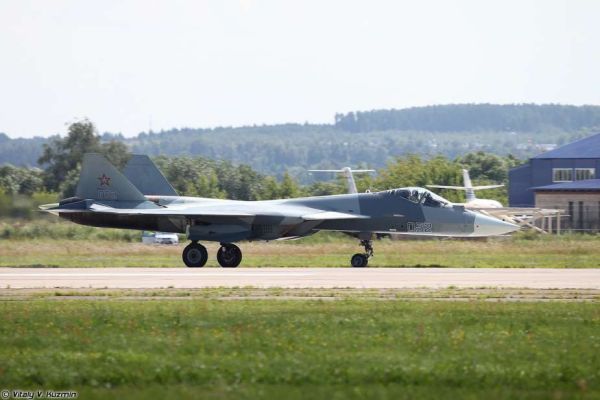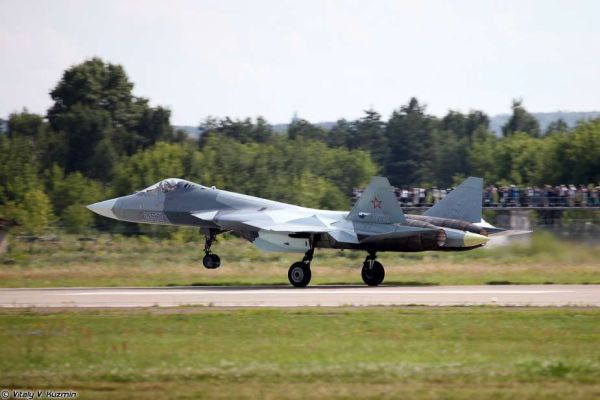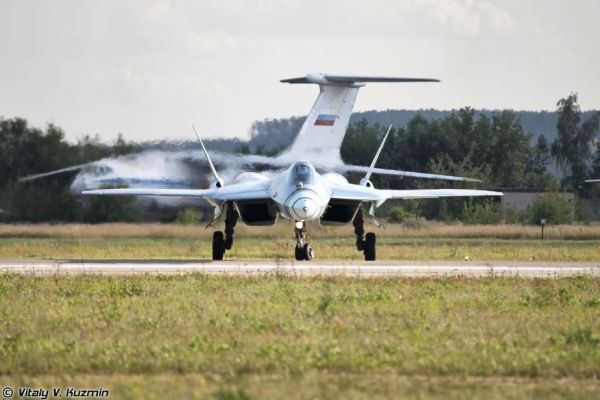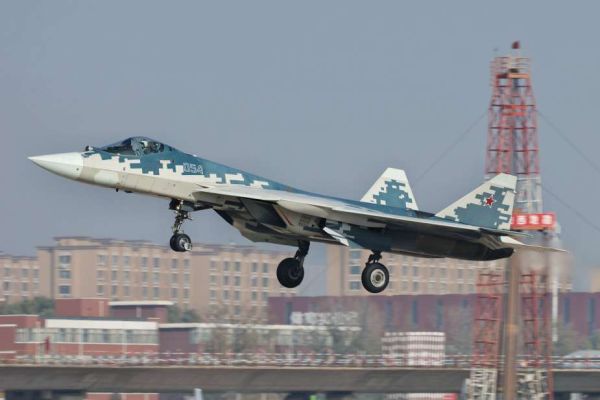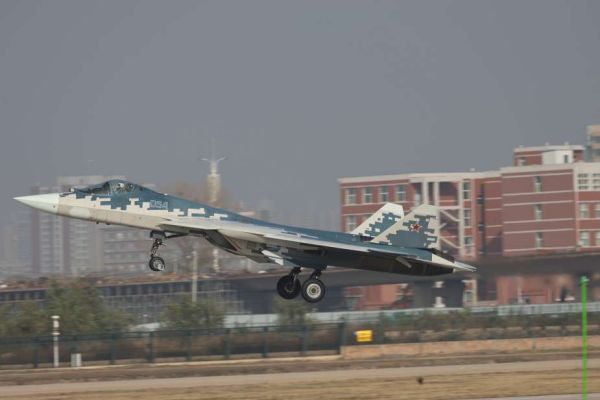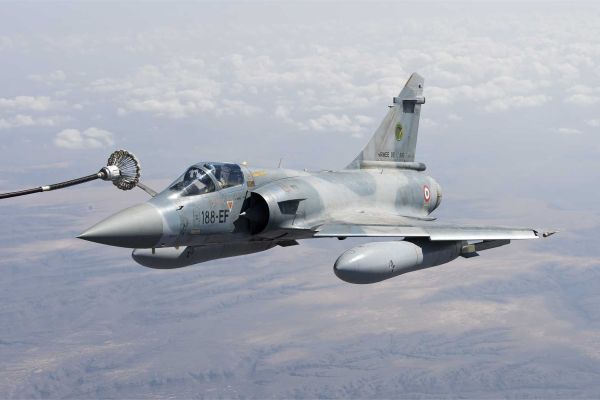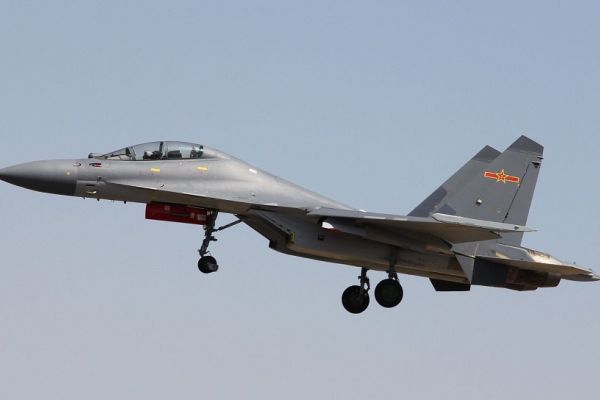Fighter.
Su-57 Felon.
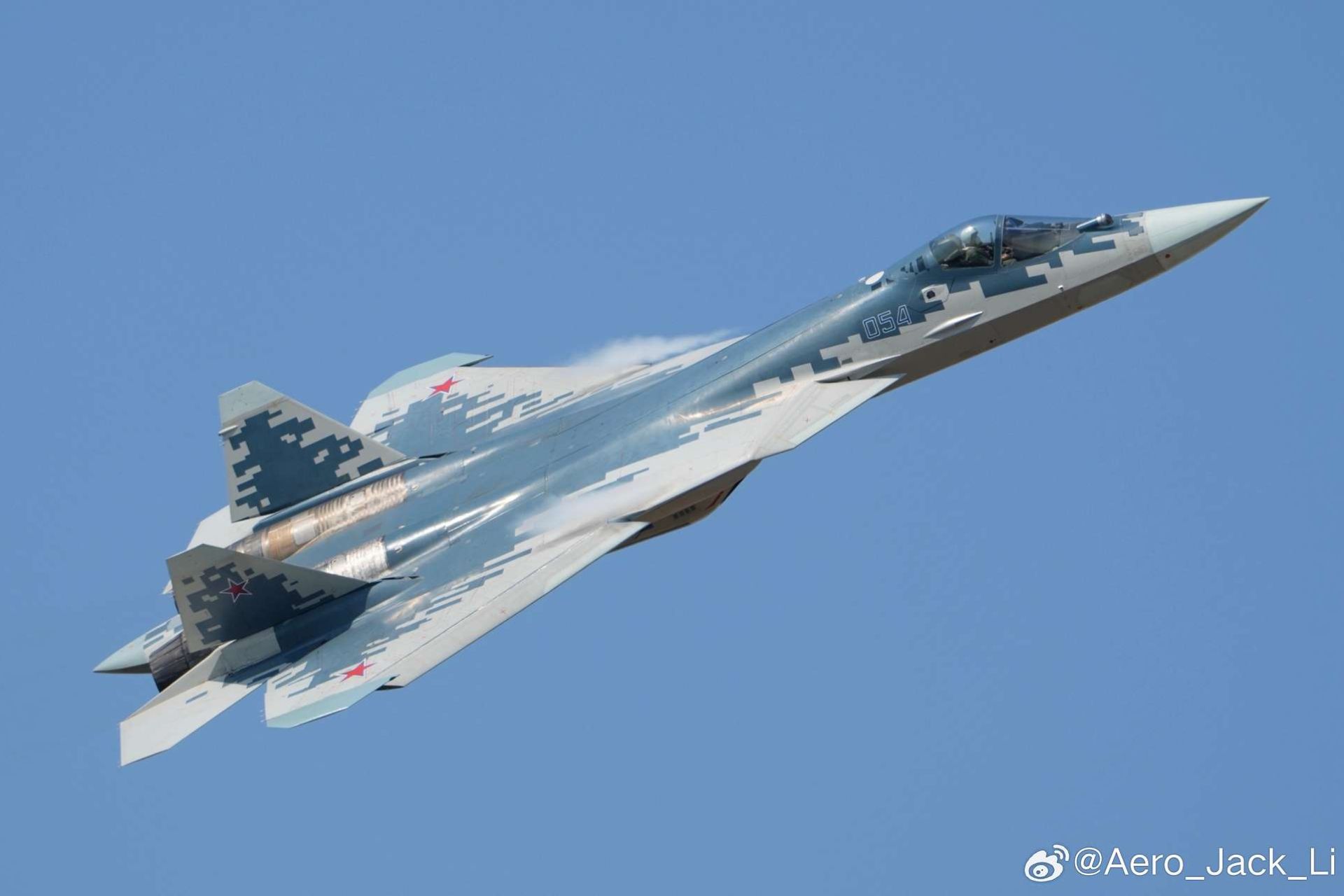
The Su-57 Felon is a fifth-generation stealth multirole fighter aircraft developed by Russia's Sukhoi Design Bureau, a subsidiary of the United Aircraft Corporation (UAC). Designed to perform both air superiority and precision strike missions, the Su-57 integrates advanced stealth technology, supermaneuverability, and sustained supersonic speeds, marking Russia's first operational stealth fighter.
Country users: Algeria, Russia
Description
The Su-57 Felon, developed under Russia’s PAK FA program, represents the country’s first stealth multirole fighter, designed to replace aging Soviet-era platforms like the MiG-29 and Su-27 in the Russian Aerospace Forces. Developed by Sukhoi, a key division within the United Aircraft Corporation (UAC), the project, originally codenamed Stolitsa (Capital City), brought together expertise from prominent Russian aerospace entities. In 2002, Alexander Davidenko was appointed as the T-50’s chief designer at Sukhoi, overseeing a collaborative effort with the Novosibirsk Aircraft Production Association (NAPO) and Komsomolsk-on-Amur Aircraft Production Association (KnAAZ), with final assembly conducted at KnAAZ in Komsomolsk-on-Amur. This collaborative approach across multiple facilities helped accelerate development and ensure a broad base of technical input.
The aircraft’s avionics suite was crafted by a consortium of Russian defense and aerospace firms selected in 2003 after a rigorous competition. Tekhnokompleks Scientific and Production Center, the Ramenskoye Instrument Building Design Bureau, the Tikhomirov Scientific Research Institute of Instrument Design (NIIP), the Ural Optical and Mechanical Plant (UOMZ), Polet, and the Central Scientific Research Radio Engineering Institute in Moscow collectively contributed to the Su-57’s advanced sensor, radar, and electronic warfare (EW) capabilities. In parallel, NPO Lyulka-Saturn (now NPO Saturn) was contracted in 2004 to develop the AL-41F1 engines, designated as "Izdeliye 117" (Product 117), specifically engineered to deliver the power, thrust vectoring, and supercruise capabilities required for the Su-57’s combat profile.
To mitigate development risks and contain costs, Sukhoi used various prototype aircraft to test Su-57 components. The Su-47 airframe tested internal weapon bays, while the Su-27M prototypes were used to evaluate the flight control systems and engines. Sukhoi also integrated elements of the Su-57’s technology into an upgraded variant of the Su-27, which eventually entered service as the Su-35S in 2014, bridging the gap between fourth-generation fighters and the anticipated fifth-generation capabilities of the Su-57.
By December 2004, the conceptual design of the Su-57 was completed and received formal approval from Russia’s Ministry of Defence. Government funding increased significantly in 2006 to support the next stages, and by 2007, Russian military officials confirmed the aircraft was ready for construction, with flight testing of initial prototypes expected by 2009. The T-50 was officially re-designated the Su-57 in July 2017.
Russia also pursued international partnerships early in the PAK FA program, seeking additional funding and long-term export orders. In 2007, Russia and India entered into a joint development contract, with Hindustan Aeronautics Limited (HAL) collaborating with Sukhoi on a derivative known as the Fifth Generation Fighter Aircraft (FGFA). Although both countries initially committed $6 billion to the project, India later withdrew in 2018, citing concerns over cost, workshare, and perceived capability gaps. Despite this setback, Sukhoi advanced the Su-57 project, promoting it to potential export clients. At the MAKS-2019 air show, the export variant, designated Su-57E, was unveiled, showcasing the aircraft’s advanced capabilities to a global defense market. The Su-57 was also presented at AirShow China 2024 in Zhuhai, marking its first official appearance at China’s premier aviation event and reinforcing its export appeal to prospective international clients.
On November 24, 2024, during the 2024 Airshow China in Zhuhai, Russia’s state defense agency Rosoboronexport announced that it had secured its first international buyer for the Su-57E stealth fighter, the export variant of its fifth-generation aircraft, but declined to disclose the identity of the customer. This revelation has intensified speculation, with Algeria emerging as the most likely candidate due to its decades-long military ties with Russia and ongoing efforts to modernize its air force with advanced technology, positioning itself as a prominent contender for this groundbreaking fighter jet.
Algeria confirmed the acquisition of the Russian Su-57E stealth fighter jets in February 2025 through an official announcement on national television. The contract had been signed earlier in November 2024 and includes an initial batch of six aircraft. Algerian pilots are currently undergoing training in Russia, with the first deliveries expected by the end of 2025.
Su-57 variants:
- Su-57 (Baseline Variant): The original fifth-generation stealth multirole fighter developed by Sukhoi for the Russian Aerospace Forces. This variant focuses on air superiority, precision strike, and reconnaissance with advanced stealth and avionics capabilities.
- Su-57E (Export Variant): The Su-57E is an export-oriented version unveiled at the MAKS-2019 air show, intended to attract international buyers with capabilities tailored to comply with export restrictions while retaining core stealth and multirole functions.
- Su-57M (Upgraded Variant): An enhanced version of the Su-57 expected to incorporate the new Izdeliye 30 engines, which improve thrust, efficiency, and supercruise capabilities. This variant is also anticipated to feature advanced avionics and additional stealth improvements.
- Su-75 Checkmate (Single-Engine Variant): Although not a direct Su-57 variant, the Su-75 Checkmate is a light, single-engine fighter inspired by the Su-57’s design philosophy. Developed for affordability, ease of maintenance, and stealth, the Checkmate targets export markets and complements the heavier Su-57 platform.
- FGFA (Fifth Generation Fighter Aircraft): A proposed joint development between Russia and India based on the Su-57, also known as the FGFA. The project aimed to produce a customized version tailored to Indian requirements but was eventually canceled in 2018 due to performance concerns and cost issues.
Technical Data
-
Design
The Su-57 features a sleek, twin-engine design optimized for stealth and superior aerodynamic performance. The aircraft measures 20.1 meters in length, with a wingspan of 14.1 meters and a height of 4.6 meters. Its wing area is 78.8 square meters. The empty weight is approximately 18,500 kilograms, with a normal takeoff weight of 26,700 kilograms and a maximum takeoff weight of 35,000 kilograms. The airframe incorporates a high percentage of composite materials and radar-absorbing coatings, significantly reducing its radar cross-section. The internal weapons bays and carefully designed airframe contribute to its low observability while providing supercruise capability, allowing the aircraft to maintain supersonic speeds without afterburners.
-
Armament
The Su-57 is designed with two main internal weapons bays within the fuselage, along with two smaller bays near the engine nacelles, allowing it to carry a range of munitions without compromising its stealth profile. For air-to-air combat, the Su-57 can deploy R-77M active radar-guided missiles for long-range engagements, R-74M2 infrared-guided missiles for short-range dogfighting, and R-37 missiles for extended-range engagements. Its air-to-ground strike capabilities include four Kh-38M tactical missiles and four Kh-59MK2 stealth cruise missiles, designed for precision strikes, as well as the Kh-69 missile. For anti-ship missions, it can carry two Kh-35U or two Kh-31 missiles. To counter enemy radar installations, the Su-57 is equipped with four Kh-58UShK anti-radiation missiles. Additionally, the aircraft can carry KAB-250 and KAB-500 guided bombs, and it has options for specialized anti-tank cluster munitions, such as the 500-kilogram "Drill" cluster bomb with active homing. For close-range engagements, the Su-57 is armed with a 30 mm GSh-30-1 internal cannon, enhancing its effectiveness in dogfight scenarios. Overall, the Su-57's design allows it to carry a total payload of up to 10,000 kilograms across its internal and external hardpoints, depending on mission requirements.
-
Propulsion and Engine
The Su-57 is powered by two Saturn AL-41F1 afterburning turbofan engines, each capable of producing a dry thrust of 88.3 kilonewtons and an afterburner thrust of 142.2 kilonewtons, with an emergency power setting yielding 147.1 kilonewtons. These engines allow the Su-57 to achieve a maximum speed of Mach 2 (approximately 2,135 km/h) at high altitude and Mach 1.1 (1,350 km/h) at sea level. The aircraft has a supercruise capability at Mach 1.3 (1,400 km/h) at high altitude. The operational range extends to approximately 3,500 kilometers subsonic and 1,500 kilometers supersonic, with a combat radius of 1,250 kilometers. The ferry range, with two outboard fuel tanks, is 4,500 kilometers. The service ceiling is 20,000 meters. The engines feature thrust-vectoring nozzles, providing supermaneuverability and enhancing agility during combat, allowing the Su-57 to perform controlled, high-angle maneuvers critical for close-quarters engagements.
-
Avionics and Onboard Equipment
The Su-57's avionics suite is built around the Sh-121 multifunctional integrated radio electronic system (MIRES), which includes the N036 Byelka active electronically scanned array (AESA) radar. This radar system offers high-precision multi-target tracking and engagement capabilities, essential for both air-to-air and air-to-ground operations. The aircraft is equipped with the L402 Himalayas electronic countermeasure suite, enhancing survivability by detecting, jamming, and countering a variety of threats. The 101KS Atoll electro-optical targeting system includes an infrared search and track (IRST) system, allowing passive target detection and tracking, preserving stealth by avoiding radar emissions. The Su-57 also features secure, high-speed communication systems that enable real-time data-sharing within networked combat scenarios, enhancing its role in complex, multi-unit engagements. Additionally, the cockpit is equipped with a helmet-mounted display (HMD), providing pilots with critical flight data and combat information within their line of sight, improving response time and situational awareness.
Specifications
-
Type
Fifth-Generation Stealth Multirole Fighter
-
Country users
Algeria, Russia
-
Designer Country
Russia (Sukhoi Design Bureau, part of United Aircraft Corporation)
-
Crew
1
-
Armament
- Guns: 1 × 30 mm GSh-30-1 autocannon
- Missiles:
- Air-to-Air: R-77M, R-74M2, R-37
- Air-to-Surface: 4 × Kh-38M, 4 × Kh-59MK2, Kh-69
- Anti-Ship: 2 × Kh-35U, 2 × Kh-31
- Anti-Radiation: 4 × Kh-58UShK
- Bombs: KAB-250 and KAB-500 guided bombs, 500 kg Drill anti-tank cluster bomb with active homing
-
Avionics
- Sh-121 multifunctional integrated radio electronic system (MIRES)
- N036 Byelka AESA radar with X-band frontal radar and additional cheek radars for extended angular coverage
- L-band slat arrays for IFF (Identification Friend or Foe)
- L402 Himalayas electronic countermeasure suite
- 101KS Atoll electro-optical targeting system, including IRST, laser directional infrared countermeasures, and missile approach warning systems
-
Weight
- Empty Weight: 18,500 kg
- Normal Takeoff Weight: 26,700 kg
- Max Takeoff Weight: 35,000 kg
-
Engine
- Engines: 2 × Saturn AL-41F1 afterburning turbofan engines (future models will feature Izdeliye 30 engines)
- Thrust: 88.3 kN each dry, 142.2 kN with afterburner (147.1 kN in emergency power)
- Range: 3,500 km subsonic, 1,500 km supersonic
- Ferry Range: 4,500 km with two external fuel tanks
-
Speed
-
- Max Speed: Mach 2 (approx. 2,135 km/h) at high altitude
- Supercruise: Mach 1.3 (1,400 km/h) at high altitude
-
-
Dimensions
Length: 20.1 m; Height: 4.6 m; Wingspqan: 14.1 m





























